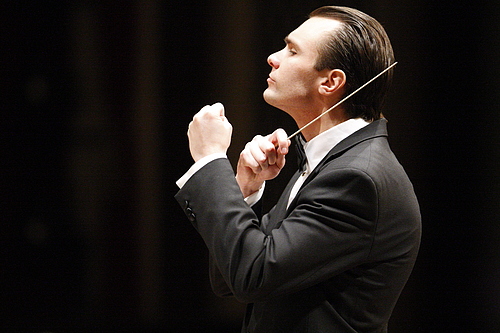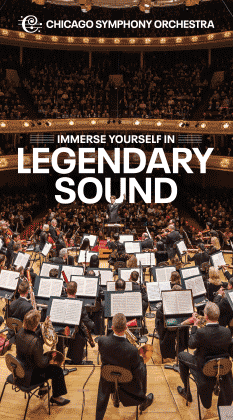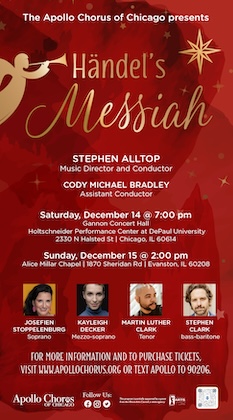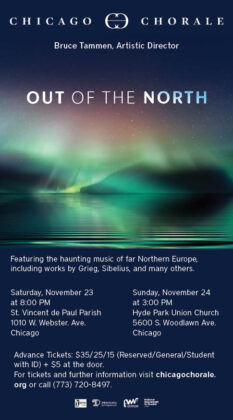A tragic anniversary observed with powerful premiere of “Ukrainian Requiem”

In the harsh winter of 1932-33, under directions from Stalin, the Soviet Union instituted a manipulated starvation of Ukraine (then part of the USSR). As many as ten million are estimated to have perished in this communist genocide, called the “Holodomor”or murder by starvation.
The 85th anniversary of this devastating—and still largely unknown—tragedy, was marked with a concert Saturday night at the Harris Theater, presented by the Chicago-based Ukrainian Genocide Famine Foundation and the Chicago Consulate of Ukraine.
The main event was the belated North American premiere of Yevhen Stankovych’s Ukrainian Requiem performed by the Kalamazoo Philharmonia, conducted by Andrew Koehler.
Written in 1993, the Ukrainian Requiem is scored on a large scale, for two soloists large orchestra and chorus. While there is a clear spiritual dimension to the work, the traditional church Latin Requiem text is not used; rather Stanykovych sets texts by poet Dmytro Pavlychko that are more historic and nationalistic.
The work begins with a call to the “eternal cathedral of memory” to honor the famine victims; it then segues from paying tribute to the industrious wheat farmers to the death and devastation of the famine—denouncing the Soviet “wolves and assassins”- and ending with a prayer to “protect us and our country from bloody ill-fated evil.”
At times the score resembles more of a vocal cantata for chorus than symphony per se; the bass soloist acts largely as narrator, which gives a certain didactic quality to the work.
Stanyovych’s 45-minute Requiem is a written with undeniable craft, the chorus, soloists and orchestra skillfully balanced and blended. Cast in fifteen continuous sections, it wasn’t always clear where one was in the narrative until one of the eight vocal sections appeared, as a kind of useful signpost.
Yet for all its imposing sonic power, depth of feeling and (richly justified) nationalistic fervor, I can’t say that the Ukrainian Requiem is a neglected masterpiece. While there are some striking moments, too much of the score relies on unvaried sonic bombast and sheer volume, as with the bass soloist’s angry, repeated declamations. The passing, more lightly scored elegiac sections, often with sweet-toned solo violin–prove more striking. Ultimately, one comes away more aware of the looming influences—Mahler in the opening section, Gorecki in the soprano solo, as well as Holst and Shostakovich–more than any strong individual voice in Stankovych’s score.
That said, there was no lack of passion or commitment in the powerful performance led by Andrew Koehler. The young conductor, an American of Ukrainian heritage, clearly feels strongly about this music and he drew an incisive well-balanced performance from the large forces.
Composed of students and faculty from Kalamazoo College, the Kalamazoo Philharmonia gave a most impressive accounting of itself, playing Stankovuch’s music with full commitment; concertmaster Joanna Steinhauser brought a sweet-toned, elegaic expression to her violin solos.
The two veteran soloists were well suited to their parts. Stefan Szkafarowsky’s initial booming delivery was painfully loud in its amplification, though better balanced after the veteran bass stepped back from the microphone. Most of his assignment was as dramatic narrator but in his brief vocal moments, Szkafarowsky brought an imposing, flexible voice to his singing.
Perhaps a younger female soloist would have brought greater freshness and gleam to the central soprano solo. Yet the veteran singer Nina Matvienko brought an identification and emotional connection to the text–a child’s devastating plea to be reunited in heaven with her mother—and Matvienko’s worn, vulnerable tone and sensitive delivery conveyed the painful words with emotional impact. Refusing to sit after her single solo moment and standing, eyes downcast, for the rest of the performance, the 70-year-old singer seemed almost a physical embodiment of the famine victims.
The Kalamazoo Bach Festival Chorus was equally committed though their enunciation was often so cloudy it was hard to know what language they were singing in, let alone the words.
The evening began with performances by the Women’s Bandura Ensemble of North America. The bandura is a unique 65-stringed Ukrainian instrument–zither-like though with a lighter and more refined sound.
The 18 Ukrainian-American musicians sat in a wide semicircle and showcased their versatility, singing as well as playing their instruments.
Conductors Oksana Rodak and Oksana Zelinska took turns switching from the first chair as bandura leader to conducting in front of the group; both elicited alert and well coordinated performances, with Zelinska, especially, drawing expressively shaped singing.
Befitting the occasion, the selections leaned toward the elegiac and mournful but all were accomplished and polished, with an espeically effective arrangement of Bortniansky’s haunting “Beneath Thy Mercy.”
Matviyenko sang a solo in the final selection (“Across the Wide Field”); even with amplification her voice sounded dry and thin, though the native folk flavor was fully manifest.
Actor George Wyhinny offered dramatic readings from his one-man play Buried Truth, which paints the historic background of the famine and the reporters who exposed it as well as those who tried to cover up the tragedy. Though the characters weren’t always quite clear in this excerpted format, Wyhinny’s strong voice and impassioned performance were consistently compelling.
For more information go to the Ukrainian Genocide Famine Foundation at ukrainiangenocide.org.
Posted in Performances




Posted May 21, 2018 at 3:41 pm by Peter-DG
It’s encouraging to see your review of this performance. This is a political issue that need to be recognized even today. In the face of genocide, be it today or 85 years ago, humanity should take action rather than look the other way.
I concur with most of your comments. Much of the amplification was excessive. Except for the actor, the forces on stage would have sounded better without any amplification, at least through the front half of that hall. The Harris like to over amplify to get that booming sound all the way up to Randolph Street level.
As to the Chorus, I was amazed as to how much of their Ukrainian was understandable. I’m somewhat conversant in the language. They have sung Ukrainian holiday songs in the past and apparently someone has done a great job of language coaching.
Posted May 22, 2018 at 9:16 am by Anatoliy
I am glad that the Ukrainian Requiem event caught attention of Lawrence A. Johnson.
As a native Ukrainian speaker I was quite amazed by how authentically the Chorus sounded. They have done amazing work on pronunciation! Quite remarkable! I am wondering what kind of phonetic training they went through to achieve such a result.
It would be so great to see some videos of the performance. It truly deserves to be preserved and shared. It might become quite an inspiration for other choruses taking on Slavic repertoire.
As to the Bandura performance, I think the Ensemble delivered a great deal, given that the setting was quite unfavorable: they ended up isolated from orchestra shell by sound adsorbing curtain. This certainly has taken away a lot of their wonderful sound. From where I stand, they should have been placed inside of the orchestra shell.
I also agree with Peter-DG and Mr. Johnson about amplification issues.